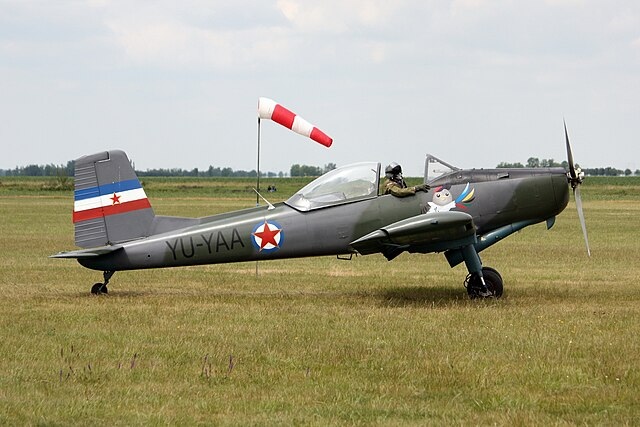J-20 Kraguj
Summary
| Category | Combat Aircraft |
| Origin country | 🇳🇱 Ex-Yugoslavia |
| Manufacturer | SOKO |
| First flight | 21 November 1962 |
| Year introduced | 1964 |
| Number produced | 43 units |
Description
The Soko J-20 Kraguj was designed by VTI and manufactured by SOKO in Yugoslavia. It first flew in 1962. This light military, single-engine, low-wing single-seat aircraft with a metal airframe, was designed to perform close air support, counterinsurgency (COIN), and reconnaissance missions.
The Soko J-20 Kraguj features a classic semi-monocoque, metal structure with a slightly tapered wing. The pilot is accommodated in an enclosed, heated, and ventilated cockpit, equipped with adjustable seats, with the cockpit canopy sliding backwards to open. The landing gear is non-retractable and includes a tail wheel. Shock absorption is achieved through rubber dampers, and hydraulic brakes provide wheel braking. The powerplant consists of one 340 hp Textron Lycoming GSO-480-B1J6 piston engine coupled with a Hartzell HC-B3Z20-1/10151C-5 three-blade metal variable-pitch propeller. Engine cooling airflow is enhanced by two specially designed ejectors. The aircraft carries 36 US Gal of fuel in two rubber tanks, enabling a flight range of 350 NM with a full armament configuration. A 1.5 kW generator and a storage battery supply 28 V DC electric power. The windshield is defogged and de-iced by blowing hot air.
The J-20 Kraguj features a permanent armament of two wing-mounted 7.7 mm Colt–Browning Mk II machine guns, each with a capacity of 650 rounds, complemented by a collimator sight in the cockpit. For combat missions, it is equipped with underwing pylons capable of carrying external loads including bombs (such as 100 kg bombs, cluster bombs, and cargo bombs), multi-tube launchers for twelve 57 mm air-to-ground rockets, and launchers for 128 mm (HVAR-5) air-to-ground rockets. Adapters on the underwing pylons facilitate the configuration switch between various free-fall bombs and rocket launchers.
The Soko J-20 Kraguj was conceived with a unique operational doctrine in mind, drawing from Yugoslavia's experiences in WWII. It was designed to function as a "Partisan aircraft," providing reconnaissance and strike capabilities to guerilla groups should the Yugoslav Air Force be neutralized early in a conflict. To that end, the Kraguj was designed to operate from short, unimproved airstrips, especially in mountainous regions, and was even capable of being fitted with skis. In addition to its primary ground support role, it also served as a trainer for basic flight and advanced ground attack training. The type was used by the SFR Yugoslav Air Force, the Air Force of Republika Srpska, and the Croatian Air Force.
Main Variants:
- The standard J-20, the primary production model designed for close air support, counterinsurgency, and reconnaissance.
Technical specifications
| Version: J-20 | |
|---|---|
| Crew | 1 pilot |
| Maximum speed | 295 km/h (183 mph) |
| Wing area | 17 m² (183.0 sqft) |
| Wingspan | 10.6 m (34.9 ft) |
| Height | 3 m (9.8 ft) |
| Length | 7.9 m (26.0 ft) |
| Service ceiling | 8,000 m (26,247 ft) |
| Empty weight | 1,130 kg (2,491 lbs) |
| Max. takeoff weight | 1,624 kg (3,580 lbs) |
| Climb rate | 8.0 m/s (26.2 ft/s) |
| Powerplant | 1 x pistons engine Lycoming GSO-480-B1A6 delivering 254 kW each |
Current operating countries
All operators
